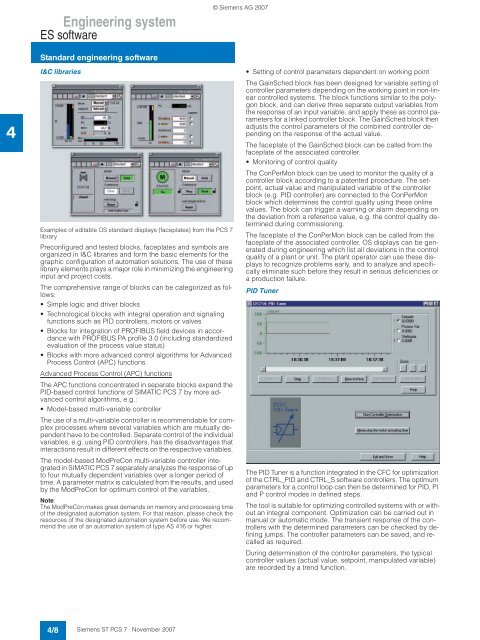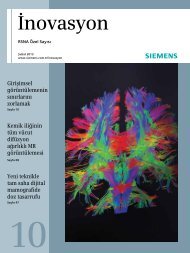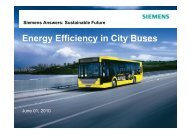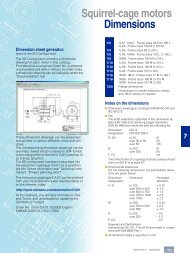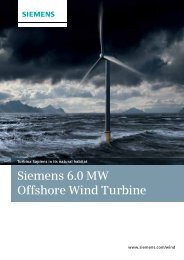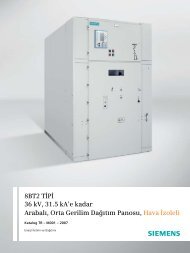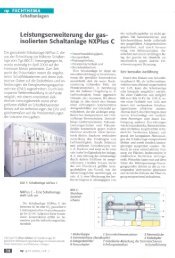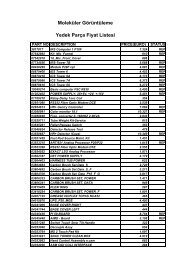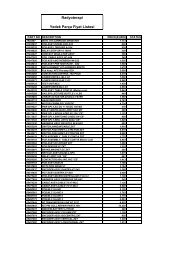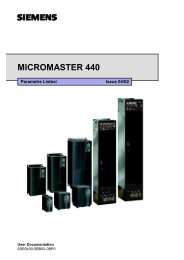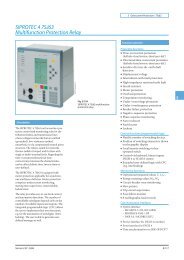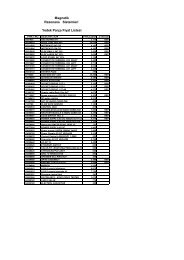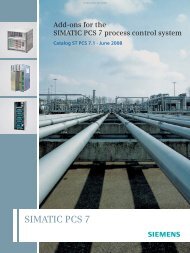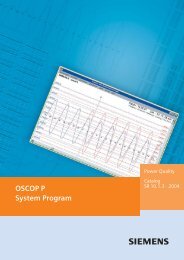SIMATIC PCS 7 Process Control System - Siemens
SIMATIC PCS 7 Process Control System - Siemens
SIMATIC PCS 7 Process Control System - Siemens
You also want an ePaper? Increase the reach of your titles
YUMPU automatically turns print PDFs into web optimized ePapers that Google loves.
4<br />
Engineering system<br />
ES software<br />
Standard engineering software<br />
I&C libraries<br />
Examples of editable OS standard displays (faceplates) from the <strong>PCS</strong> 7<br />
library<br />
Preconfigured and tested blocks, faceplates and symbols are<br />
organized in I&C libraries and form the basic elements for the<br />
graphic configuration of automation solutions. The use of these<br />
library elements plays a major role in minimizing the engineering<br />
input and project costs.<br />
The comprehensive range of blocks can be categorized as follows:<br />
• Simple logic and driver blocks<br />
• Technological blocks with integral operation and signaling<br />
functions such as PID controllers, motors or valves<br />
• Blocks for integration of PROFIBUS field devices in accordance<br />
with PROFIBUS PA profile 3.0 (including standardized<br />
evaluation of the process value status)<br />
• Blocks with more advanced control algorithms for Advanced<br />
<strong>Process</strong> <strong>Control</strong> (APC) functions<br />
Advanced <strong>Process</strong> <strong>Control</strong> (APC) functions<br />
The APC functions concentrated in separate blocks expand the<br />
PID-based control functions of <strong>SIMATIC</strong> <strong>PCS</strong> 7 by more advanced<br />
control algorithms, e.g.:<br />
• Model-based multi-variable controller<br />
The use of a multi-variable controller is recommendable for complex<br />
processes where several variables which are mutually dependent<br />
have to be controlled. Separate control of the individual<br />
variables, e.g. using PID controllers, has the disadvantages that<br />
interactions result in different effects on the respective variables.<br />
The model-based ModPreCon multi-variable controller integrated<br />
in <strong>SIMATIC</strong> <strong>PCS</strong> 7 separately analyzes the response of up<br />
to four mutually dependent variables over a longer period of<br />
time. A parameter matrix is calculated from the results, and used<br />
by the ModPreCon for optimum control of the variables.<br />
Note:<br />
The ModPreCon makes great demands on memory and processing time<br />
of the designated automation system. For that reason, please check the<br />
resources of the designated automation system before use. We recommend<br />
the use of an automation system of type AS 416 or higher.<br />
4/8<br />
<strong>Siemens</strong> ST <strong>PCS</strong> 7 · November 2007<br />
© <strong>Siemens</strong> AG 2007<br />
• Setting of control parameters dependent on working point<br />
The GainSched block has been designed for variable setting of<br />
controller parameters depending on the working point in non-linear<br />
controlled systems. The block functions similar to the polygon<br />
block, and can derive three separate output variables from<br />
the response of an input variable, and apply these as control parameters<br />
for a linked controller block. The GainSched block then<br />
adjusts the control parameters of the combined controller depending<br />
on the response of the actual value.<br />
The faceplate of the GainSched block can be called from the<br />
faceplate of the associated controller.<br />
• Monitoring of control quality<br />
The ConPerMon block can be used to monitor the quality of a<br />
controller block according to a patented procedure. The setpoint,<br />
actual value and manipulated variable of the controller<br />
block (e.g. PID controller) are connected to the ConPerMon<br />
block which determines the control quality using these online<br />
values. The block can trigger a warning or alarm depending on<br />
the deviation from a reference value, e.g. the control quality determined<br />
during commissioning.<br />
The faceplate of the ConPerMon block can be called from the<br />
faceplate of the associated controller. OS displays can be generated<br />
during engineering which list all deviations in the control<br />
quality of a plant or unit. The plant operator can use these displays<br />
to recognize problems early, and to analyze and specifically<br />
eliminate such before they result in serious deficiencies or<br />
a production failure.<br />
PID Tuner<br />
The PID Tuner is a function integrated in the CFC for optimization<br />
of the CTRL_PID and CTRL_S software controllers. The optimum<br />
parameters for a control loop can then be determined for PID, PI<br />
and P control modes in defined steps.<br />
The tool is suitable for optimizing controlled systems with or without<br />
an integral component. Optimization can be carried out in<br />
manual or automatic mode. The transient response of the controllers<br />
with the determined parameters can be checked by defining<br />
jumps. The controller parameters can be saved, and recalled<br />
as required.<br />
During determination of the controller parameters, the typical<br />
controller values (actual value, setpoint, manipulated variable)<br />
are recorded by a trend function.


